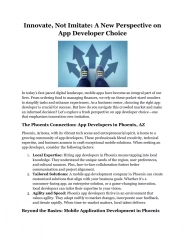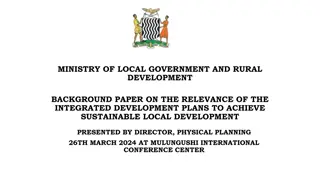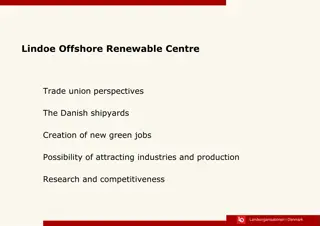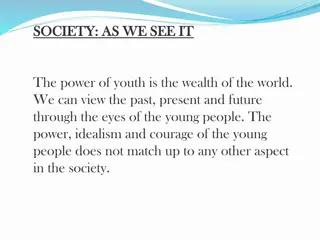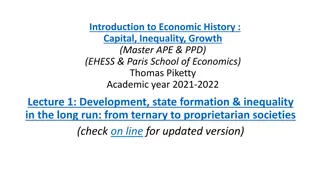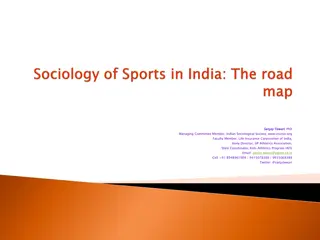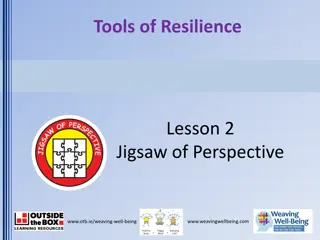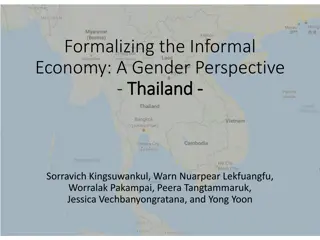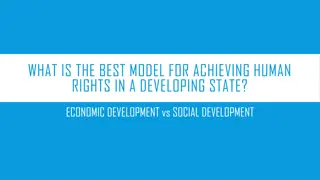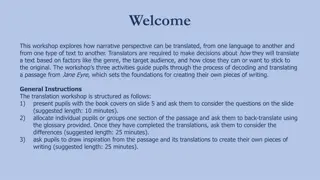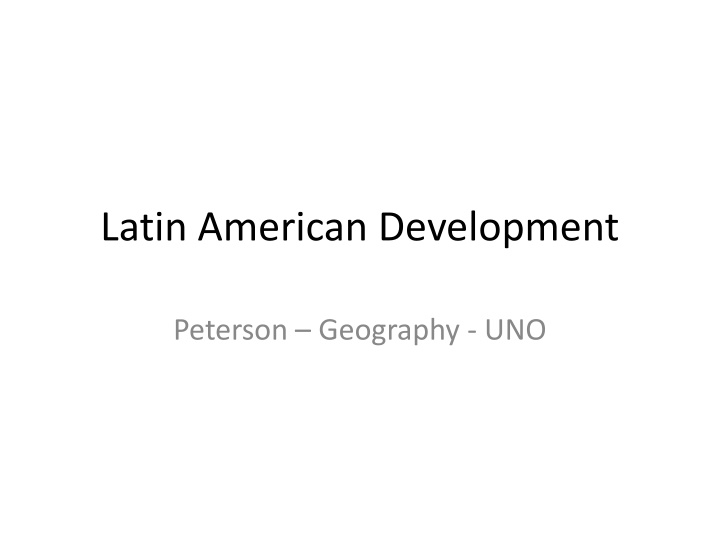
Latin American Independence Movement and Bolivar's Leadership
Explore the rapid independence movement in Latin America starting in 1809, following 300 years of colonial rule. Highlighting key events and figures like Bolivar, who played a pivotal role in liberating Venezuela, Colombia, and Ecuador.
Download Presentation

Please find below an Image/Link to download the presentation.
The content on the website is provided AS IS for your information and personal use only. It may not be sold, licensed, or shared on other websites without obtaining consent from the author. If you encounter any issues during the download, it is possible that the publisher has removed the file from their server.
You are allowed to download the files provided on this website for personal or commercial use, subject to the condition that they are used lawfully. All files are the property of their respective owners.
The content on the website is provided AS IS for your information and personal use only. It may not be sold, licensed, or shared on other websites without obtaining consent from the author.
E N D
Presentation Transcript
Latin American Development Peterson Geography - UNO
Outline Longer colonial rule Different ways toward independence Measures of development Variations within countries
Independence Occurred rapidly starting in 1809 after 300 years of Iberian control In 1808 Napoleon invades Spain, secures the abdication of the Spanish king Ferdinand VII, and places his own brother, Joseph Bonaparte, on the throne. With no Spanish government in Spain, argument is made that overseas provinces must take care of themselves It is also argued that local governments should be set up on behalf of the deposed Spanish king.
Domino Effect April 1810: Venezuelan officers expel Spanish governor May 1810: Regional government takes over Argentina, on behalf of Ferdinand VII July 1810: New Granada (Colombia) Royal officers are thrown out who had stated allegiance to deposed King. September 1810: Mexico rebellion September 1810: Spanish governor resigns at open town meeting.
Bolivar Venezuelan involved in the overthrow of the Spanish governor in 1810 1812: Spanish authorities regain control, Bolivar escapes to Cartagena, Colombia. Writes Manifesto de Cartagena, offers vision of united effort to expel Spaniards In 1813 he returns to Venezuela as liberator and takes control In 1814 he loses control of Caracas again, marches to Bogot and captures from Spanish 1817 he loses control of Bogot and flees to Jamaica and Haiti
Bolivar continues 1817: Back in Venezuela, he conceives a bold plan to retake Bogota by a route thought impossible up the Orinoco and over the mountains. August 1819: Bolivar and 2500 men defeat Spanish at Boyac . Enters Bogot three days later. December 1819: Republica de Colombia is proclaimed (Colombia, Ecuador, and Venezuela) 1821: Secures control of Venezuela 1822: Secures control of Ecuador
Bolivar and San Martin Jos de San Martin, Argentine-born officer Assembles and trains army for campaign against Peru, a rich Spanish stronghold With help of Chilean ally, Bernardo O Higgins, he takes control of Chile in 1817 1822: San Martin meets Bolivar at Guayaquil Conference (Ecuador) to divide up Peru Bolivar is not willing to cooperate, San Martin slips away from conference and escapes to Europe 1824: Bolivar and his general, Antonio Jos de Sucre, takes control of Peru
Bolivar and Bolivia Upper Peru (Bolivia) administered by Lima Includes mineral-rich city of Potosi 1825: Rep blica Bol var is proclaimed in honor of Bol var City is named for Sucre and he is elected president for life His reign lasts less than two years
Bolivars Pan America 1826 conference in Panama. Falls short of Pan-American gathering that Bolivar had intended In contrast to northern hemisphere, Latin America never becomes a united state
Mexico In South America, educated officers led the fight against Spain In contrast, in Mexico, Catholic priests led armies of mestizos and Indians. 1810: Hidalgo, parish priests in the city of Dolores, proclaims independence, equality for races, and redistribution of land. Hidalgo tried and executed; cause continues under more pragmatic priest, Jos Mar a Morelos y Pav n 1813: Morelos y Pav n gains independence 1815: Spanish regain control and execute Morelos 1821: Treaty of Cord ba recognizes the independence of Mexico
World Development? First, Second, and Third World
Categorizing World Development Capitalist World / Socialist World / Third World Underdeveloped Country (UDC) and Developed Country (DC) Less Developed Country (LDC), Moderately Developed Country (MDC), and Highly Developed Country (HDC)
Characteristics of an LDC Little to no build-up of agriculture Low energy production and consumption Subsistence farming (farm only for themselves) Large percentage of the population is under 15 (causing a high birthrate because a large percentage of the population is entering it's "reproductive stage") Infant mortality rate is high Poorly developed trade and transportation Poor medical facilities High illiteracy and unemployment rates GNI PPP is under $3,000 per year.
Characteristics of HDC Opposite of LDC, and Disproportionate energy consumption US burns 25-40% of world energy having only 4.6% of the world s population Labor and brain drain from less developed parts of the world Use of military intervention to protect foreign- invested capital and secure supply of resources
Potential list of non-economic HDC goals 1. Inclusion of all age groups and people in economic prosperity. 2. Careful use of resources. 3. A stable society in which young people can find their "place". 4. Development of technology that enhances standards of living instead of finding better ways of killing people.
MDC Almost all of Latin America is in the moderately developed category, with great variations within each country Future of LDC and MDC countries? lies in the hands of HDC s HDC's are able to maintain the status quo
Dependency Theory body of theories that suggest that the wealthy nations of the world need a peripheral group of poorer states in order to remain wealthy poverty of the countries in the periphery is not because they are not integrated into the world system It is because of how they are integrated into the system.
Dependency Theory poor nations provide natural resources, cheap labor, a destination for obsolete technology, and markets to the wealthy nations, without which they could not have the standard of living they enjoy Rich nations perpetuate a state of dependency through various policies and initiatives. Any attempt by the dependent nations to resist the influences of dependency could result in economic sanctions and/or military invasion and control.
Dependency Theory Based on 1950s research that found that the wealth of poor nations tended to decrease when the wealth of rich nations increased Theory became aligned with Marxism American sociologist Wallerstein refined the Marxist aspect of the theory, and called it the "world system."
World System a set of mechanisms which redistributes resources from the periphery to the core core is the developed, industrialized part of the world, and the periphery is the "underdeveloped market is the means by which the core exploits the periphery. a social system, one that has boundaries, structures, member groups, rules of legitimation, and coherence. Its life is made up of the conflicting forces which hold it together by tension and tear it apart as each group seeks eternally to remold it to its advantage.
Dependency and the World System poverty and backwardness of poor countries are caused by their peripheral position. Cardoso (1979) proposes that: 1. there is a financial and technological penetration by the developed capitalist centers of the countries of the periphery and semi-periphery 2. produces an unbalanced economic structure within the peripheral societies and among them and the centers 3. leads to limitations upon self-sustained growth in the periphery 4. favors the appearance of specific patterns of class relations 5. requires modifications in the role of the state to guarantee the functioning of the economy
Infant Mortality 2000
Percent of Children Age 0-5 Underweight

